

Compact Muon Solenoid
LHC, CERN
| CMS-PAS-B2G-16-001 | ||
| Search for single production of vector-like quarks decaying into final states with a Z boson and a top or a bottom quark | ||
| CMS Collaboration | ||
| July 2016 | ||
| Abstract: A search for the single production of vector-like quarks, $T$ and $B$, decaying into a Z boson and a top or a bottom quark respectively, is presented using data collected by the CMS experiment in proton-proton collisions at $\sqrt{ s } =$ 13 TeV. An additional exotic production mode is studied for the $T$ quark, i.e. the production of a heavy resonance $Z^{\prime}$ with its subsequent decay into $Tt$. The search has been performed in events with a Z boson decaying leptonically, accompanied by a bottom or a top quark decaying hadronically. Observed production cross sections for $T$ and $B$ in the range between 0.97 and 0.13 pb are excluded at 95% confidence level, depending on the resonance mass that ranges from 0.7 to 1.7 TeV, while observed production cross sections for $Z^{\prime}$ are excluded in the range between 0.31 and 0.14 pb, in a mass range between 1.5 and 2.5 TeV. | ||
|
Links:
CDS record (PDF) ;
inSPIRE record ;
CADI line (restricted) ;
These preliminary results are superseded in this paper, JHEP 05 (2017) 029. The superseded preliminary plots can be found here. |
||
| Figures | |

png pdf |
Figure 1-a:
Production of a single $T$ and its decay to a Z boson and a t quark. |

png pdf |
Figure 1-b:
Production of a single $B$ and its decay to a Z boson and a b quark. |

png pdf |
Figure 2-a:
Comparison between data and simulation for the reconstructed top mass in the four $T$ categories, after preselection only. No cuts on $\Delta R(lep1,lep2)$, number of b-jets and ${p_{\mathrm {T}}}$ of the leading muon are applied. |

png pdf |
Figure 2-b:
Comparison between data and simulation for the reconstructed top mass in the four $T$ categories, after preselection only. No cuts on $\Delta R(lep1,lep2)$, number of b-jets and ${p_{\mathrm {T}}}$ of the leading muon are applied. |

png pdf |
Figure 2-c:
Comparison between data and simulation for the reconstructed top mass in the four $T$ categories, after preselection only. No cuts on $\Delta R(lep1,lep2)$, number of b-jets and ${p_{\mathrm {T}}}$ of the leading muon are applied. |

png pdf |
Figure 2-d:
Comparison between data and simulation for the reconstructed top mass in the four $T$ categories, after preselection only. No cuts on $\Delta R(lep1,lep2)$, number of b-jets and ${p_{\mathrm {T}}}$ of the leading muon are applied. |
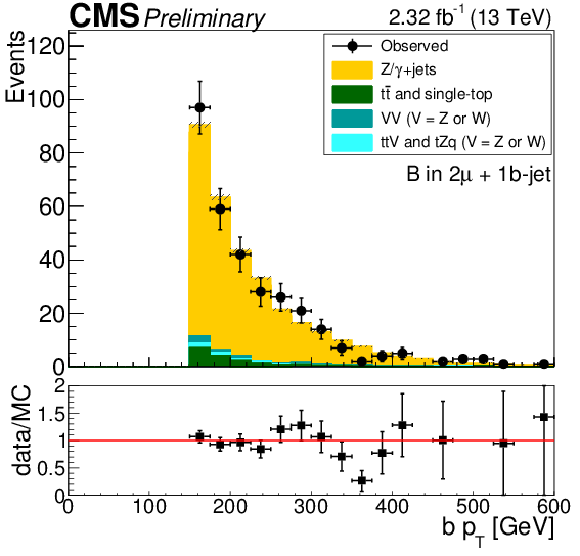
png pdf |
Figure 3-a:
Comparison between data and simulation for the $b$ quark ${p_{\mathrm {T}}}$ in the two $B$ categories, after preselection only. No cuts on $\Delta R(lep1,lep2)$, number of b-jets and ${p_{\mathrm {T}}}$ of the leading muon are applied. |

png pdf |
Figure 3-b:
Comparison between data and simulation for the $b$ quark ${p_{\mathrm {T}}}$ in the two $B$ categories, after preselection only. No cuts on $\Delta R(lep1,lep2)$, number of b-jets and ${p_{\mathrm {T}}}$ of the leading muon are applied. |
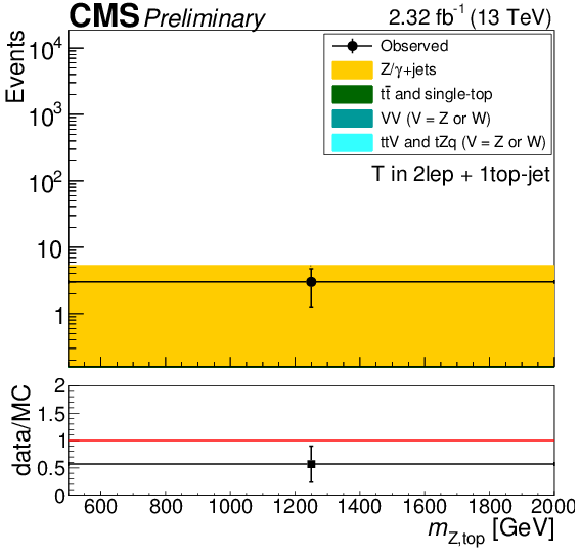
png pdf |
Figure 4-a:
Number of events in the control region $N_{cr}(M_{T/B})$ for the fully merged region (a), partially merged region (b), resolved region (c,d) and events with a Z boson and a b-jet (e,f), for events with a Z boson decaying into muons (c,e) and electrons (d,f). For the fully merged region and the partially merged region, events with Z to muons and events with Z to electrons are taken together. For the fully merged region, no shape analysis is performed due to reduced statistics so one single bin is shown. |

png pdf |
Figure 4-b:
Number of events in the control region $N_{cr}(M_{T/B})$ for the fully merged region (a), partially merged region (b), resolved region (c,d) and events with a Z boson and a b-jet (e,f), for events with a Z boson decaying into muons (c,e) and electrons (d,f). For the fully merged region and the partially merged region, events with Z to muons and events with Z to electrons are taken together. For the fully merged region, no shape analysis is performed due to reduced statistics so one single bin is shown. |

png pdf |
Figure 4-c:
Number of events in the control region $N_{cr}(M_{T/B})$ for the fully merged region (a), partially merged region (b), resolved region (c,d) and events with a Z boson and a b-jet (e,f), for events with a Z boson decaying into muons (c,e) and electrons (d,f). For the fully merged region and the partially merged region, events with Z to muons and events with Z to electrons are taken together. For the fully merged region, no shape analysis is performed due to reduced statistics so one single bin is shown. |

png pdf |
Figure 4-d:
Number of events in the control region $N_{cr}(M_{T/B})$ for the fully merged region (a), partially merged region (b), resolved region (c,d) and events with a Z boson and a b-jet (e,f), for events with a Z boson decaying into muons (c,e) and electrons (d,f). For the fully merged region and the partially merged region, events with Z to muons and events with Z to electrons are taken together. For the fully merged region, no shape analysis is performed due to reduced statistics so one single bin is shown. |

png pdf |
Figure 4-e:
Number of events in the control region $N_{cr}(M_{T/B})$ for the fully merged region (a), partially merged region (b), resolved region (c,d) and events with a Z boson and a b-jet (e,f), for events with a Z boson decaying into muons (c,e) and electrons (d,f). For the fully merged region and the partially merged region, events with Z to muons and events with Z to electrons are taken together. For the fully merged region, no shape analysis is performed due to reduced statistics so one single bin is shown. |
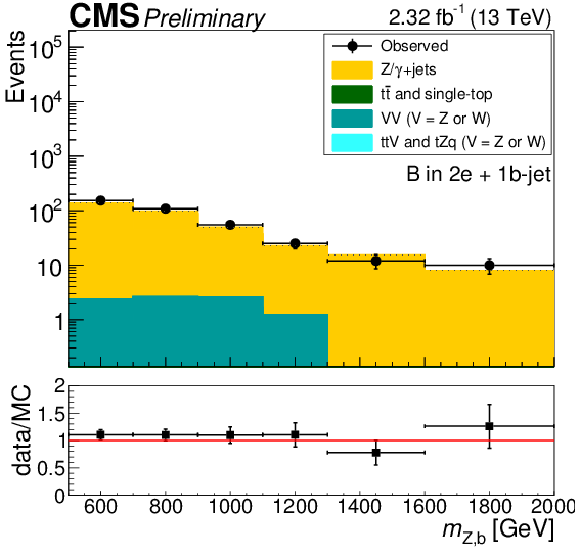
png pdf |
Figure 4-f:
Number of events in the control region $N_{cr}(M_{T/B})$ for the fully merged region (a), partially merged region (b), resolved region (c,d) and events with a Z boson and a b-jet (e,f), for events with a Z boson decaying into muons (c,e) and electrons (d,f). For the fully merged region and the partially merged region, events with Z to muons and events with Z to electrons are taken together. For the fully merged region, no shape analysis is performed due to reduced statistics so one single bin is shown. |
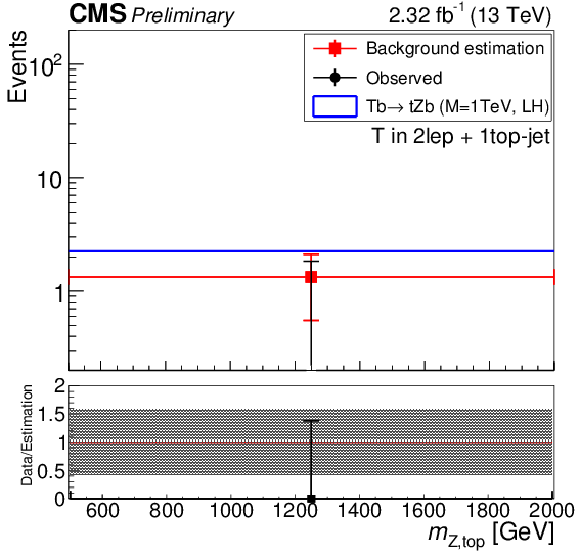
png pdf |
Figure 5-a:
Comparison between the background estimated with the alpha method and observed data for the $T$ categories: fully merged region (a), partially merged region (b), and resolved region (c,d) for events with a Z boson decaying into muons (c) and electrons (d). For the fully merged region and the partially merged region, events with Z to muons and events with Z to electrons are taken together. For the fully merged region, no shape analysis is performed due to reduced statistics so one single bin is shown. The uncertainties on the background estimation method include both statistical and systematic errors, as described in section 7. |
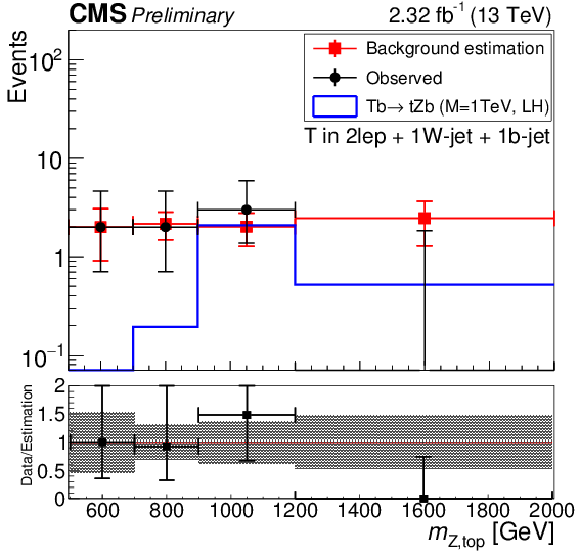
png pdf |
Figure 5-b:
Comparison between the background estimated with the alpha method and observed data for the $T$ categories: fully merged region (a), partially merged region (b), and resolved region (c,d) for events with a Z boson decaying into muons (c) and electrons (d). For the fully merged region and the partially merged region, events with Z to muons and events with Z to electrons are taken together. For the fully merged region, no shape analysis is performed due to reduced statistics so one single bin is shown. The uncertainties on the background estimation method include both statistical and systematic errors, as described in section 7. |

png pdf |
Figure 5-c:
Comparison between the background estimated with the alpha method and observed data for the $T$ categories: fully merged region (a), partially merged region (b), and resolved region (c,d) for events with a Z boson decaying into muons (c) and electrons (d). For the fully merged region and the partially merged region, events with Z to muons and events with Z to electrons are taken together. For the fully merged region, no shape analysis is performed due to reduced statistics so one single bin is shown. The uncertainties on the background estimation method include both statistical and systematic errors, as described in section 7. |

png pdf |
Figure 5-d:
Comparison between the background estimated with the alpha method and observed data for the $T$ categories: fully merged region (a), partially merged region (b), and resolved region (c,d) for events with a Z boson decaying into muons (c) and electrons (d). For the fully merged region and the partially merged region, events with Z to muons and events with Z to electrons are taken together. For the fully merged region, no shape analysis is performed due to reduced statistics so one single bin is shown. The uncertainties on the background estimation method include both statistical and systematic errors, as described in section 7. |
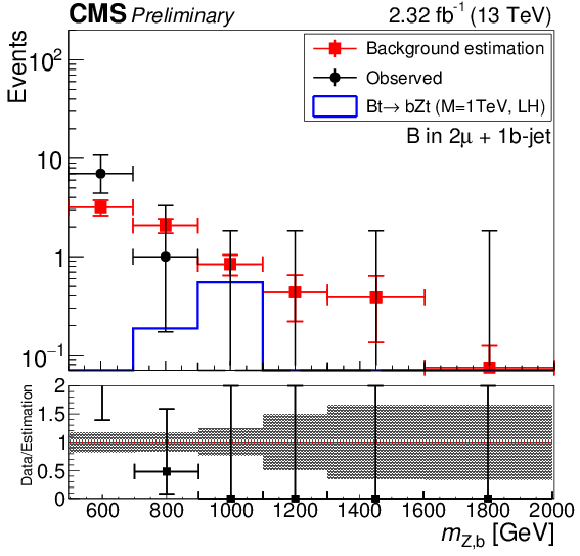
png pdf |
Figure 6-a:
Comparison between the background estimated with the alpha method and observed data for the $B$ categories: events with $Z$ to muons (a) and to electrons (b). The uncertainties on the background estimation method include both statistical and systematic errors, as described in section 7. |

png pdf |
Figure 6-b:
Comparison between the background estimated with the alpha method and observed data for the $B$ categories: events with $Z$ to muons (a) and to electrons (b). The uncertainties on the background estimation method include both statistical and systematic errors, as described in section 7. |
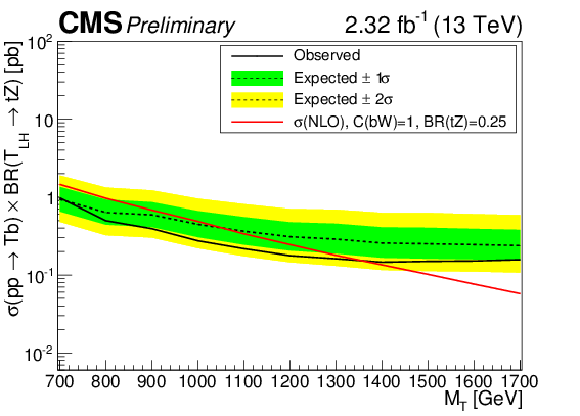
png pdf |
Figure 7-a:
Observed and expected upper limit on the $\sigma \cdot BR$ for the singlet LH $Tb$ (a) and doublet RH $Tt$ (b) production mode. |
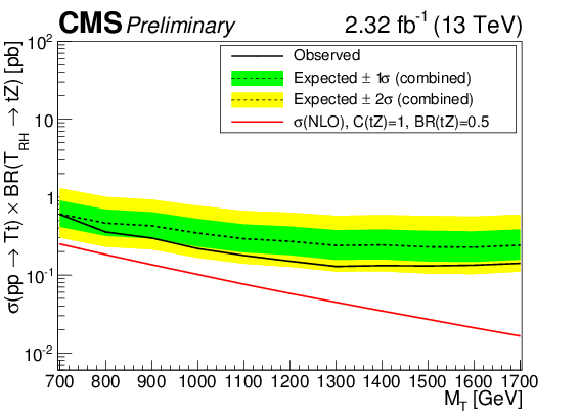
png pdf |
Figure 7-b:
Observed and expected upper limit on the $\sigma \cdot BR$ for the singlet LH $Tb$ (a) and doublet RH $Tt$ (b) production mode. |

png pdf |
Figure 8-a:
Observed and expected upper limit on the $\sigma \cdot BR$ for the $Bt$ (a) and $Bb$ (b) signal in the singlet LH scenario. |
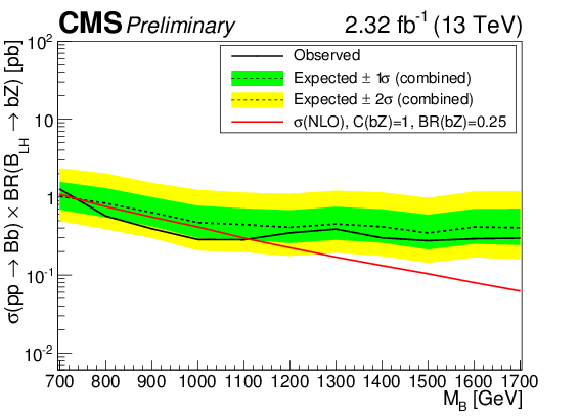
png pdf |
Figure 8-b:
Observed and expected upper limit on the $\sigma \cdot BR$ for the $Bt$ (a) and $Bb$ (b) signal in the singlet LH scenario. |
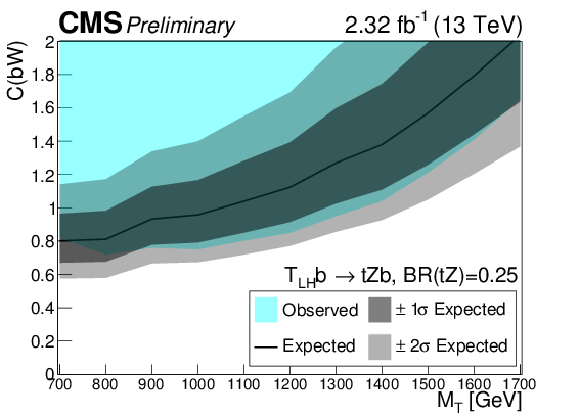
png pdf |
Figure 9-a:
Exclusion region in the plane defined by: (a) the mass of the $T$ resonance and the coupling $C(bW)$ for LH $Tb$ production mode, under the assumption that the $T$ is a singlet; (b) the mass of the $T$ resonance and the coupling $C(tZ)$ for the RH scenario, considering $Tt$ production mode, under the assumption that $T$ is a doublet and that $BR(T\rightarrow tZ) = BR(T\rightarrow tH) = $ 0.5 ; (c) the mass of the $B$ resonance and the coupling $C(tW)$ for the LH signal; in this case $Bt$ and $Bb$ production modes are combined together, under the assumption that $C(bW) = \sqrt {2}\cdot C(tZ)$. |
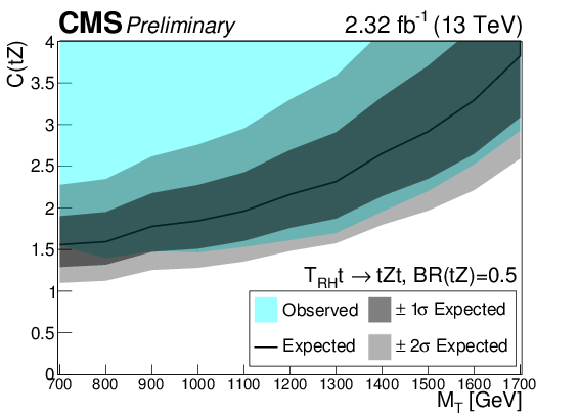
png pdf |
Figure 9-b:
Exclusion region in the plane defined by: (a) the mass of the $T$ resonance and the coupling $C(bW)$ for LH $Tb$ production mode, under the assumption that the $T$ is a singlet; (b) the mass of the $T$ resonance and the coupling $C(tZ)$ for the RH scenario, considering $Tt$ production mode, under the assumption that $T$ is a doublet and that $BR(T\rightarrow tZ) = BR(T\rightarrow tH) = $ 0.5 ; (c) the mass of the $B$ resonance and the coupling $C(tW)$ for the LH signal; in this case $Bt$ and $Bb$ production modes are combined together, under the assumption that $C(bW) = \sqrt {2}\cdot C(tZ)$. |
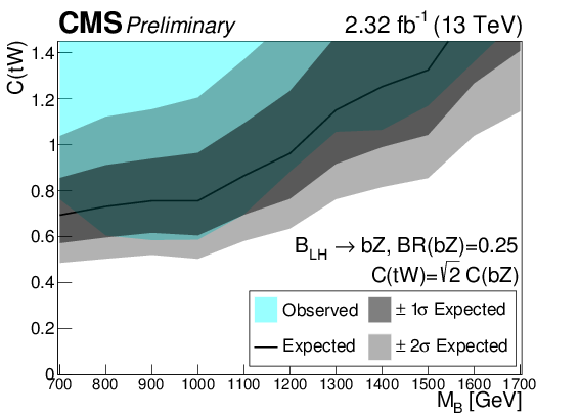
png pdf |
Figure 9-c:
Exclusion region in the plane defined by: (a) the mass of the $T$ resonance and the coupling $C(bW)$ for LH $Tb$ production mode, under the assumption that the $T$ is a singlet; (b) the mass of the $T$ resonance and the coupling $C(tZ)$ for the RH scenario, considering $Tt$ production mode, under the assumption that $T$ is a doublet and that $BR(T\rightarrow tZ) = BR(T\rightarrow tH) = $ 0.5 ; (c) the mass of the $B$ resonance and the coupling $C(tW)$ for the LH signal; in this case $Bt$ and $Bb$ production modes are combined together, under the assumption that $C(bW) = \sqrt {2}\cdot C(tZ)$. |

png pdf |
Figure 10:
Observed and expected upper limit on the $\sigma \cdot BR$ for the $Z^{\prime } \rightarrow Tt$ signal. It has been considered a 100% branching ratio (BR) of $T$ in $tZ$ final state. In order to consider different BR, the limits have to be scaled by the corresponding BR. |
| Tables | |

png pdf |
Table 1:
Theoretical cross sections for $Tb$, $Bt$, $Bb$ and $Tt$ processes for the different mass points considered in the analysis for unitary couplings. |

png pdf |
Table 2:
Event yields for background events estimated with the data-driven method and observed data. The quoted uncertainties on the background estimation from data-driven prediction include both statistical and systematic errors, as described in section 7. Expected signal yields are also shown for three example mass points. |

png pdf |
Table 3:
Summary of the systematics applied in the analysis. |
| Summary |
| A search for the single production of vector-like quarks, $T$ and $B$, has been presented. This is the first search looking for this signal performed by CMS in events with a Z boson decaying leptonically, and a bottom or a top quark decaying hadronically. Observed limits on the production cross sections for a LH $Tb$ in the range between 0.97 and 0.16 pb are set at 95% confidence level, depending on the resonance mass that ranges from 0.7 to 1.7 TeV and between 0.60 and 0.14 pb for RH $Tt$ signal. For LH $B$ produced in association with a top quark, cross sections in a range between 0.68 and 0.17 pb are excluded in the same mass range, while for $B$ produced in association with a b quark, cross section in a range between 1.27 and 0.30 pb are excluded. Finally production cross sections of a $T$ quark from the decay of a $Z^{\prime} \rightarrow Tt$ are excluded in the range between 0.31 and 0.14 pb, depending on the $Z^{\prime}$ mass between 1.5 and 2.5 TeV. |
| References | ||||
| 1 | ATLAS Collaboration | Observation of a new particle in the search for the Standard Model Higgs boson with the ATLAS detector at the LHC | PLB 716 (2012) 1 | 1207.7214 |
| 2 | CMS Collaboration | Observation of a new boson at a mass of 125 GeV with the CMS experiment at the LHC | PLB 716 (2012) 30 | CMS-HIG-12-028 1207.7235 |
| 3 | K. Agashe, R. Contino, and A. Pomarol | The Minimal composite Higgs model | Nucl. Phys. B 719 (2005) 165 | hep-ph/0412089 |
| 4 | M. Schmaltz and D. Tucker-Smith | Little Higgs review | Ann. Rev. Nucl. Part. Sci. 55 (2005) 229 | hep-ph/0502182 |
| 5 | I. Antoniadis, K. Benakli, and M. Quiros | Finite Higgs mass without supersymmetry | New J. Phys. 3 (2001) 20 | hep-th/0108005 |
| 6 | J. A. Aguilar-Saavedra, R. Benbrik, S. Heinemeyer, and M. Perez-Victoria | Handbook of vectorlike quarks: Mixing and single production | PRD 88 (2013), no. 9, 094010 | 1306.0572 |
| 7 | J. A. Aguilar-Saavedra | Identifying top partners at LHC | JHEP 11 (2009) 030 | 0907.3155 |
| 8 | A. De Simone, O. Matsedonskyi, R. Rattazzi, and A. Wulzer | A First Top Partner Hunter's Guide | JHEP 04 (2013) 004 | 1211.5663 |
| 9 | O. Eberhardt et al. | Joint analysis of Higgs decays and electroweak precision observables in the Standard Model with a sequential fourth generation | PRD 86 (2012) 013011 | 1204.3872 |
| 10 | ATLAS Collaboration | Search for production of vector-like quark pairs and of four top quarks in the lepton-plus-jets final state in $ pp $ collisions at $ \sqrt{s}=8 $ TeV with the ATLAS detector | JHEP 08 (2015) 105 | 1505.04306 |
| 11 | ATLAS Collaboration | Search for vector-like $ B $ quarks in events with one isolated lepton, missing transverse momentum and jets at $ \sqrt{s}= $ 8 TeV with the ATLAS detector | PRD 91 (2015), no. 11, 112011 | 1503.05425 |
| 12 | ATLAS Collaboration | Search for pair and single production of new heavy quarks that decay to a $ Z $ boson and a third-generation quark in $ pp $ collisions at $ \sqrt{s}=8 $ TeV with the ATLAS detector | JHEP 11 (2014) 104 | 1409.5500 |
| 13 | ATLAS Collaboration | Search for single production of a vector-like quark via a heavy gluon in the $ 4b $ final state with the ATLAS detector in $ pp $ collisions at $ \sqrt{s} = 8 $ TeV | PLB 758 (2016) 249--268 | 1602.06034 |
| 14 | ATLAS Collaboration | Search for single production of vector-like quarks decaying into $ Wb $ in $ pp $ collisions at $ \sqrt{s} = $ 8 TeV with the ATLAS detector | CERN-PH-EP-2015-319 (2016) | 1602.05606 |
| 15 | ATLAS Collaboration | Search for the production of single vector-like and excited quarks in the $ Wt $ final state in $ pp $ collisions at $ \sqrt{s} $ = 8 TeV with the ATLAS detector | JHEP 02 (2016) 110 | 1510.02664 |
| 16 | CMS Collaboration | Search for vector-like charge 2/3 T quarks in proton-proton collisions at $ \sqrt{s}=8 $ TeV | PRD 93 (2016), no. 1, 012003 | CMS-B2G-13-005 1509.04177 |
| 17 | CMS Collaboration | Search for pair-produced vector-like B quarks in proton-proton collisions at $ \sqrt{s}=8 $ TeV | PRD 93 (2016), no. 11, 112009 | CMS-B2G-13-006 1507.07129 |
| 18 | CMS Collaboration | Search for top-quark partners with charge 5/3 in the same-sign dilepton final state | PRL 112 (2014), no. 17, 171801 | CMS-B2G-12-012 1312.2391 |
| 19 | CMS Collaboration | Search for top quark partners with charge 5/3 at $ \sqrt{s}=13 $ TeV | CMS-PAS-B2G-15-006 | CMS-PAS-B2G-15-006 |
| 20 | O. Matsedonskyi, G. Panico, and A. Wulzer | On the Interpretation of Top Partners Searches | JHEP 12 (2014) 097 | 1409.0100 |
| 21 | C. Bini, R. Contino, and N. Vignaroli | Heavy-light decay topologies as a new strategy to discover a heavy gluon | JHEP 01 (2012) 157 | 1110.6058 |
| 22 | CMS Collaboration | Search for massive resonances decaying into pairs of boosted bosons in semi-leptonic final states at $ \sqrt{s} = $ 8 TeV | JHEP 08 (2014) 174 | CMS-EXO-13-009 1405.3447 |
| 23 | CMS Collaboration | Search for vector-like T quarks decaying to top quarks and Higgs bosons in the all-hadronic channel using jet substructure | JHEP 06 (2015) 080 | CMS-B2G-14-002 1503.01952 |
| 24 | CMS Collaboration | The CMS experiment at the CERN LHC | JINST 3 (2008) S08004 | CMS-00-001 |
| 25 | J. Alwall et al. | The automated computation of tree-level and next-to-leading order differential cross sections, and their matching to parton shower simulations | JHEP 07 (2014) 079 | 1405.0301 |
| 26 | P. Nason | A New method for combining NLO QCD with shower Monte Carlo algorithms | JHEP 11 (2004) 040 | hep-ph/0409146 |
| 27 | S. Frixione, P. Nason, and C. Oleari | Matching NLO QCD computations with Parton Shower simulations: the POWHEG method | JHEP 11 (2007) 070 | 0709.2092 |
| 28 | S. Alioli, P. Nason, C. Oleari, and E. Re | A general framework for implementing NLO calculations in shower Monte Carlo programs: the POWHEG BOX | JHEP 06 (2010) 043 | 1002.2581 |
| 29 | S. Alioli, S.-O. Moch, and P. Uwer | Hadronic top-quark pair-production with one jet and parton showering | JHEP 01 (2012) 137 | 1110.5251 |
| 30 | T. Sjostrand, S. Mrenna, and P. Z. Skands | PYTHIA 6.4 Physics and Manual | JHEP 05 (2006) 026 | hep-ph/0603175 |
| 31 | GEANT4 Collaboration | GEANT4: A Simulation toolkit | NIMA 506 (2003) 250 | |
| 32 | J. Allison et al. | Geant4 developments and applications | IEEE Trans. Nucl. Sci. 53 (2006) 270 | |
| 33 | CMS Collaboration | Description and performance of track and primary-vertex reconstruction with the CMS tracker | JINST 9 (2014), no. 10, P10009 | CMS-TRK-11-001 1405.6569 |
| 34 | CMS Collaboration | Particle-Flow Event Reconstruction in CMS and Performance for Jets, Taus, and MET | CDS | |
| 35 | CMS Collaboration | Commissioning of the Particle-flow Event Reconstruction with the first LHC collisions recorded in the CMS detector | CDS | |
| 36 | CMS Collaboration | Performance of CMS muon reconstruction in $ pp $ collision events at $ \sqrt{s}=7 $ TeV | JINST 7 (2012) P10002 | CMS-MUO-10-004 1206.4071 |
| 37 | S. Baffioni et al. | Electron reconstruction in CMS | EPJC 49 (2007) 1099 | |
| 38 | M. Cacciari, G. P. Salam, and G. Soyez | The Anti-k(t) jet clustering algorithm | JHEP 04 (2008) 063 | 0802.1189 |
| 39 | S. D. Ellis, C. K. Vermilion, and J. R. Walsh | Techniques for improved heavy particle searches with jet substructure | PRD 80 (2009) 051501 | 0903.5081 |
| 40 | CMS Collaboration | Identification techniques for highly boosted W bosons that decay into hadrons | JHEP 12 (2014) 017 | CMS-JME-13-006 1410.4227 |
| 41 | CMS Collaboration | Search for massive resonances decaying into pairs of boosted W and Z bosons at $ \sqrt{s} $ = 13 TeV | CMS-PAS-EXO-15-002 | CMS-PAS-EXO-15-002 |
| 42 | A. J. Larkoski, S. Marzani, G. Soyez, and J. Thaler | Soft Drop | JHEP 05 (2014) 146 | 1402.2657 |
| 43 | CMS Collaboration | Identification of b-quark jets with the CMS experiment | JINST 8 (2013) P04013 | CMS-BTV-12-001 1211.4462 |
| 44 | CMS Collaboration | Electron reconstruction and identification at $ \sqrt{s}=7 $ TeV | CDS | |
| 45 | ATLAS, CMS Collaboration | Procedure for the LHC Higgs boson search combination in summer 2011 | CMS-NOTE-2011-005 | |

|
Compact Muon Solenoid LHC, CERN |

|

|

|

|

|

|